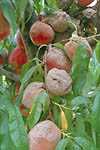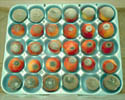Melissa B. Riley
Department of Entomology, Soils, and Plant Sciences
Clemson University
mbriley@clemson.edu
It took Mr. Watson and Angie ten minutes to drive out to Mr. Jones’s packing shed. As they arrived they saw a tractor bringing peaches in from the field. Mr. Jones walked out of the packing shed and upon seeing Mr. Watson came over to the truck.
“I am so happy to see you, Tony. It has been a while since you have been out to see me. Come over and look at the peaches in the field and after harvest. This is what my peaches look like (Figure 4-5). I have been trying to determine my losses and I estimate that we are losing approximately 45% of the crop. My losses are usually less than 5%. I don’t know what is going on. The only thing that would explain it is that some of the chemicals that I have been using are not worth the money I paid for them.”

Figure 4. Brown rot in the field |

Figure 5. Brown rot after harvest |
Mr. Watson finally got a word in, “Mr. Jones, I would like for you to meet Angie Hill. She is a student at Clemson working on a degree in Agricultural Education. This summer she is doing an internship with me. I would like her to ask some questions and hopefully we can determine what your problem is between us.”
“I am happy to meet you Angie. I hope you can help me. So what are your questions?”
“Well Mr. Jones, what fungicides did you use this year and last year, how often did you apply your fungicides, and what were your application rates? Also, has the weather been any different this year? Has it been more favorable for disease development?” Angie asked quickly.
“Whoa, Angie, I need to think about each of those questions. We also need to find Jon, my farm manager, to find out what fungicides were used and at what rates. I can answer right away that the weather has not really been any different from other years, so I don’t think weather has been more favorable for disease development this year” replied Mr. Jones as they walked into the packing shed. “I think Jon is in the office right now and we can check on the fungicides used. Jon, let me introduce you to Angie and Mr. Watson. They are with the Clemson Extension service. I am hoping that they can help us figure out why we have such a problem with brown rot this year.”
“Nice meeting you. What can I do to help?” responded Jon after the introduction.
Angie again quickly asked her questions. “What fungicides have you used this year? When were they applied? What were the application rates? What were the weather conditions immediately after their application?”
Jon turned to the laptop computer on the desk. “Let me see. I have all the data here on my computer. I know that the chemicals that we have been applying are the same ones that we applied the past three years. They have worked well for us, so we decided to stay with the same program. The chemicals were Indar and Orbit. I know that we are using the recommended rates. Let me see, in all three years we made four fungicide applications during the year to control brown rot. We made the first application during bloom and the three others were made 18, 9 and 1 day pre-harvest. We updated our fungicide spray schedule three years ago to reduce the number of sprays that we were applying from 7 sprays to 4 overall sprays for brown rot control. We have also been alternating between Indar and Orbit to prevent resistance development. I called our neighbor, Mrs. Hobbs, and she has been spraying on approximately the same dates that we have been spraying, but she said that she is using Abound with Indar instead of Orbit. Her incidence of brown rot is no higher than normal, about 5%. Because Mrs. Hobbs is using Indar and not Orbit, we think the Orbit that we obtained is ineffective.” (Spray treatments and assessment of brown rot for the two growers for the past 3 years are shown in Table 1.)
“I am considering suing the dealer where we purchased the Orbit because of our losses,” Mr. Jones jumped into the conversation. “I have never had such dramatic losses. Our losses are generally around 5 to 10%. They have never been 45%. We are having problems shipping any of our peaches to the New York City markets due to the losses.”
Angie thought she knew what was happening after she looked at the notes she had compiled on chemicals used for brown rot management. She was wondering how well Mr. Jones and Jon would respond to what she thought was causing their problem. How should she present the possible problem? Suddenly her easy summer job did not seem easy at all. In a way she hoped Mr. Watson would take over at this point and explain why the losses due to brown rot had increased.
Table 1. Influence of pre-harvest fungicide programs over three years on mean percentage of brown rot infected peaches at harvest.
| Fungicide Program | Mean % 2 years ago | Mean % Previous Year | Mean % Current Year |
|---|
| Indar and Orbita (Mr. Jones) | 1.9 | 1.1 | 45.7 |
| Abound and Indara (Mrs. Hobbs) | 2.9 | 1.2 | 4.3 |
a Fungicide programs consisted of four fungicide applications, alternating between the two chemicals listed. Fungicides were applied at recommended rates. The first fungicide application was made at 25% bloom and the three remaining applications were made 18, 9 and 1 days pre-harvest.
Questions Related to Case – Part B
- What types of chemicals did Mr. Jones and Mrs. Hobbs use? What are the differences between the chemicals that the two peach growers used?
- What do you think Angie has identified as the reason why Mr. Jones has observed an increase in the incidence of brown rot in his peaches this year?
- Do you think Mr. Jones has any basis for suing the chemical supplier? Why or why not?
- What type of test could you do to determine if Angie’s hypothesis about the cause of the problem is correct? How could you set it up?
- Why did it take three years for the problem to develop at Mr. Jones’s orchard? What happened during that three-year period? Why did Mrs. Hobbs not have a similar increase in brown rot?
- Based on the information you have, what would you suggest as a disease management program for the next year?
Get the Answers to these questions
References:
Damicone, John. 1996. Fungicide Resistance Management. Oklahoma Cooperative Extension Service F-7663. (http://pods.dasnr.okstate.edu/docushare/dsweb/Get/Document-2317/F-7663web.pdf)
2007 Southeastern peach, nectarine, and plum pest management and culture guide. Bulletin 1171. D. Horton, P. Branner, B. Bellinger and D. Ritchie, eds. (Updated annually. Sections important to case include: Management Guide, Resistance Management, Pesticide Characteristics and Restrictions sections)
